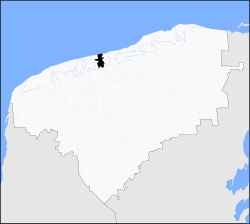Sinanché Municipality
Sinanché Municipality (In the Yucatec Maya Language: “scorpion tree”) is one of the 106 municipalities in the Mexican state of Yucatán containing 131.57 square kilometres (50.80 sq mi) of land and located roughly 60 kilometres (37 mi) northeast of the city of Mérida.[2]
Sinanché | |
|---|---|
Municipality | |
Principal Church of Sinanché, Yucatán | |
 Municipal location in Yucatán | |
 Sinanché Location of the Municipality in Mexico | |
| Coordinates: 21°13′30″N 89°11′06″W | |
| Country | |
| State | |
| Government | |
| • Type | |
| • Municipal President | Felipe De Jesus Rojas Escalante[2] |
| Area | |
| • Total | 131.57 km2 (50.80 sq mi) |
| [2] | |
| Elevation | 6 m (20 ft) |
| Population (2010[3]) | |
| • Total | 3,126 |
| Time zone | UTC-6 (Central Standard Time) |
| • Summer (DST) | UTC-5 (Central Daylight Time) |
| INEGI Code | 068 |
| Major Airport | Merida (Manuel Crescencio Rejón) International Airport |
| IATA Code | MID |
| ICAO Code | MMMD |
History
During pre-Hispanic times, the town fell within the provinces under the chieftainship of Ceh Pech. After the conquest the area became part of the encomienda system.[2] The first encomendero was Ambrosio de Villafrades (1549) who was followed by Juan de la Cámara (1579). He passed the estate to Juan Xuárez de la Cámara in 1607 and by 1625 it was in the possession of Diego and Francisca del Rey. By 1668 the encomendero was José Yngrán de Malaparte, but he died without heirs. In 1692, it was assigned to Francisco A. de Ancona Hinostrosa.[4]
Yucatán declared its independence from the Spanish Crown in 1821 and in 1825, the area was assigned to the coastal region with its headquarters in Izamal Municipality. In 1918 it was designated as its own municipality.[2]
Governance
The municipal president is elected for a three-year term. The town council has four councilpersons, who serve as Secretary and councilors of policing, public sanitation, nomenclature and roads and cemeteries.[5]
The Municipal Council administers the business of the municipality. It is responsible for budgeting and expenditures and producing all required reports for all branches of the municipal administration. Annually it determines educational standards for schools.[5]
The Police Commissioners ensure public order and safety. They are tasked with enforcing regulations, distributing materials and administering rulings of general compliance issued by the council.[5]
Communities
The head of the municipality is Sinanché, Yucatán. The larger populated areas of the municipality include Chun copo, San Crisanto, San Luis, Santa Catalina, Santa Cruz, Santa Ursula, Hacienda Zayate, and Zibagón. The significant populations are shown below:[2]
| Community | Population |
|---|---|
| Entire Municipality (2010) | 3,126[3] |
| San Crisanto | 531 in 2005[6] |
| Sinanché | 2429 in 2005[7] |
Eco tourism
In the San Crisanto communal village of Sinanché Municipality the San Crisanto initiative has been launched. The objective of this initiative is to promote eco-tourism integrated with other economic activities and education, in an area “rich in biodiversity” but is subject to vagaries of weather, particularly disastrous hurricanes. The activities involved with this initiative to attract tourists are: undertaking boat trips, swimming in very clear waters of “cenotes” or sink holes, living in environmentally favourable "eco-cabins", buying locally made crafts and coconut based toffees. Other activities pursued are environmental education, mangrove conservation, adopting the "}ejido system" of "communal tenure and farming of public lands". The communal resources such as “agriculture, craft production and salt extraction" are also part of this programme. All these activities are covered under the San Crisanto Foundation launched in 2001. The project is reported to have proved economically beneficial to the community.[8]
Local festivals
Every year on 14 July is the celebration for the town's patron, San Buenaventura.[2]
Tourist attractions
- Church of San Buenaventura, built in the seventeenth century
- Hacienda Santa Cruz
References
- "Un proyecto une al PAN" (in Spanish). Mérida, Mexico: Diario de Yucatan. 23 January 2014. Archived from the original on 24 January 2014. Retrieved 3 July 2015.
- "Municipios de Yucatán »Sinanché" (in Spanish). Retrieved 3 July 2015.
- "Mexico In Figures:Sinanché, Yucatán". INEGI (in Spanish and English). Aguascalientes, México: Instituto Nacional de Estadística y Geografía (INEGI). Archived from the original on 6 May 2015. Retrieved 3 July 2015.
- García Bernal, Manuela Cristina (1978). Población y encomienda en Yucatán bajo los Austrias (in Spanish). Sevilla: Escuela de Estudios Hispano-Americanos. p. 505. ISBN 978-8-400-04399-5. Retrieved 3 July 2015.
- "Sinanché". inafed (in Spanish). Mérida, Mexico: Enciclopedia de Los Municipios y Delegaciones de México. Retrieved 3 July 2015.
- "San Crisanto". PueblosAmerica (in Spanish). PueblosAmerica. 2005. Retrieved 3 July 2015.
- "Sinanché". PueblosAmerica (in Spanish). PueblosAmerica. 2005. Retrieved 3 July 2015.
- "We Aren't Fighting Poverty Here, We're Improving the Quality of Life". Inter Press Service. 6 March 2013. Retrieved 7 August 2015.
